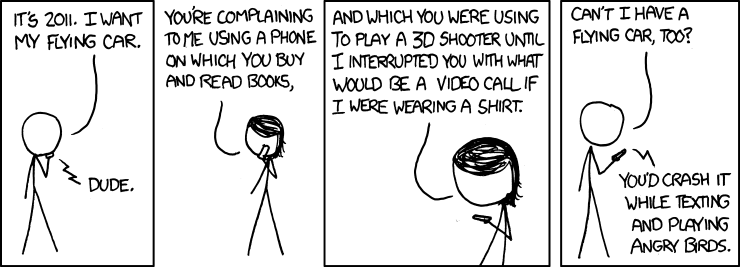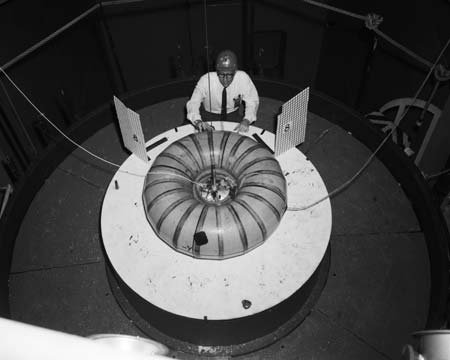Pro-Flight, Anti-Gravity

I remember seeing a commercial back in 2000. It had actor Avery Brooks (Star Trek: DS9‘s Captain Sisko) standing by a busy road. “It’s the year 2000. Where are the flying cars? I was promised flying cars!” He was talking about IBM computers and how people were commuting rather than needing flying cars. But it had me thinking, “Yeah, there were supposed to be flying cars!” So where are our flying cars? Why don’t we have flying saucers? Why is it that our greatest method of flight is a method which is almost 100 years old?
There’s no such thing as antigravity. At least, that’s what the “experts” keep telling us. That’s not a very intelligent statement to make. First of all, we don’t even know for certain what gravity is other than being a force that brings bodies of mass together. And secondly, it depends on how one defines “antigravity”.

When scientists often think of antigravity, they think of the “opposite” of gravity. They’re pretty sure that it cannot exist. But yet, they can’t even agree upon what gravity might even be. It could be mass and energy distorting space (Relativity), graviton particles (Quantum Mechanics), closed strings (Superstring Theory), or miniature Chupacabras on unicycles (I shouldn’t have eaten that burrito before I went to bed). If mass and energy can create “wells” in space-time, then could it be possible that something could create repulsive “hills”? And if it is the displacement of gravitons, then how do we know there isn’t an antigraviton simply because we haven’t found one, or that they don’t have frequency (like light) where we can produce interfering frequencies? The only two known theories that would be certain to prevent antigravity are String Theory and my late night culinary preferences.
Once we can finally figure out what gravity is, then we can royally screw with it. That is, we can make problems for it. All problems, whether medical, political, scientific, or anything else, can be attributed to any combination of four things. They are deficiency (something should be there which isn’t), poisoning (something is there which shouldn’t be), dysfunction (something isn’t behaving like it’s supposed to), and conflict (two or more things are not acting in harmony). Once we know what gravity is, there might be a chance that we could mess it up for our purposes.
But when most people think of antigravity, they think of things that simply defy gravity. I’ll give you an example. Let’s do a simple experiment. Get up and jump. Just jump straight up once. I’ll wait.
(whistles a little tune)
Are you back? Good. Did you complete the experiment? Well then you used Newton’s Third Law of Motion to defy the First. Congratulations. You just experienced antigravity. You’re now right up there with the Montgolfiers and the Wright Brothers.
Antigravity of this nature is common. We have hot air balloons, blimps, airplanes, helicopters, gliders, rockets, and so on. So when will we have our flying cars? As long as potential developers are convinced that it’s impossible, we don’t stand much of a chance. So far attempts at flying cars are little more than awkward cars with propellers which have to have wings folded out or installed before it can take flight. How inconvenient. It’s time for more options.

One that’s being talked about is having cars hover over a road which uses nano-technology to produce a magnetic field. Since it would use maglev, the road can be covered with grass, the cars can travel at over 300 mph, and human bodies can be horribly mangled with even the slightest technical glitch.
How about using Dyson Rings? (That’s what I like to call them anyway.) A few years ago, the Dyson company, known for their vacuum cleaners, came out with quiet, bladeless fans. The task is accomplished by blowing air over a round air foil, which speeds up the air. Blowing air on the outside of the ring causes more air to be pulled through the center, amplifying the airflow. Now if the conic ring can be inverted to constrict the airflow instead of blowing it outward, thus further speeding up the airflow, then perhaps with enough air power, they could provide propulsion. It could even be deployable from a smaller vehicle! Someone get James Dyson on this immediately.

Then there’s something I talked about in my last article. It’s often referred to as a “warp drive” or an “Alcubierre Drive”. This type of engine uses “negative energy” to propel space around the vehicle while it stays still. There are those who think that ships like the Enterprise going to warp are a bad idea because of inertia. Everybody would be flung against the back wall, and frankly, there aren’t enough red shirts to go around. Star Trek writers came up with “inertial dampeners” to solve that problem, but it was completely unnecessary. Think about video footage of alleged flying saucers. They suddenly zip around quickly before disappearing out of sight. Critics claim that it’s proof of fakery since the aliens on board would be dead. But if it’s using a warp drive, it isn’t even moving! It’s moving space around itself. While generally used in science fiction as a means of traveling faster than light, there is no reason a warp drive can’t be used to power a vehicle inside an atmosphere at sub-light velocities. And since it uses negative energy, I’ll think I’ll just simplify it by calling it a negative energy generating apparatus, or “nega”.
That being said, what kinds of vehicles can be nega-powered? If Marty McFly’s hoverboard was powered by a miniature nega, what would be the result? Would it be like in the movies? Being as though there are no warp fields to examine and no specific field of study dedicated to warp field dynamics, we’ll just have to speculate. There are three things that could possibly happen. First, since Marty’s feet would be inside the warp bubble and the rest of his body is not, his feet would be severed from his body at the ankles by the negative energy barrier. A second possibility is that since the nega is moving space around itself and Marty’s body is outside the bubble, he would simply be knocked off the board. His feet may be within the bubble, but they’re not immobile, and they’re attached to his body. Where his body goes, his feet go also.
But the third possibility would seem to be the most likely. Imagine you’re driving down the highway with the windows rolled down. In the passenger seat is a happy little puppy. The puppy sticks its head out the window to feel the breeze. Inertial forces and wind resistance cause the happy puppy’s tongue to nearly lick its ear. But inside the vehicle, the puppy’s tail is free to wag unimpeded by the wind. The puppy isn’t decapitated. It isn’t thrown from the car to become puppy splatter on the road. In fact, the only thing that would keep it from being a happy little puppy is if it became a happy … um … adult dog. By the same token, Marty would be able to ride the board just fine. His shoelaces don’t budge since his feet, in a relative sense, aren’t even moving. His pillow vest, on the other hand, would most certainly blow in the breeze.
Would it be dangerous to grab onto a moving object propelled by a nega? I wouldn’t advise it. In fact, it doesn’t matter if the object is using a nega or not. If the change in relative position of an object is substantially different than your own, then it’s probably not a good idea to grab it. But with a nega, the point in which the body breaks is a bit more predictable.
Now what would happen if two warp fields came into contact with each other? Probably not much. Although hyperdimensional, it’s still energy like any other energy. What happens when two magnets come close to each other, or sound waves, or light? Each has its own quirks, but no rips in the space-time continuum. I don’t see how negative energy would be any different in that regard. But until there is research in the field of warp field dynamics, we won’t know this for certain.
So there are options in the way of antigravity. Not only has antigravity in its true sense not been disproven, but there are plenty of options for producing vehicles which overcome gravity’s effects. Yes, I know about Searl discs and Hamel generators. And yes, the theories behind them seem absolutely ridiculous. But I reserve final judgment on them until I see failure with my own eyes. But to cite them as “proof” that antigravity is impossible is one of the stupidest concepts I’ve ever heard in my entire life.
So if you call yourself a scientist and claim that antigravity is impossible, you will just have to excuse me when I call you a complete idiot.
![]()





Reblogged this on Daniel C. Handley and commented:
Written for SciFi4Me.com